AI-Powered Advanced Technologies for a Sustainable Built Environment: A Systematic Review on Emerging Challenges
Abstract
1. Introduction
2. Materials and Methods
- The initial phase led to the identification of the key digital technologies enhanced by AI which are effectively contributing to fostering sustainability in the BE.
- In the second phase, an accurate analysis of the literature concerning the identified technologies with a specific focus on the actual contribution to sustainability of AI integration across the various phases of the building life cycle was carried out.
- In the third phase, the results were systematically categorized by all building life cycle phases and relevant sustainability areas of application. The resultant clustering process offers insights on building life cycle phases and sustainability categories which are most significantly impacted by AI-powered digital technologies.
2.1. Database Selection and Search Strategy
2.2. Eligibility Criteria for Documents Inclusion/Exclusion
2.3. Synthesis Methods for Results Summary
3. Results
- BIM is a key methodology of Industry 5.0 applied to the AECO sector, enhancing the digital transition by improving stakeholder coordination, reducing errors, and enhancing information management throughout the building life cycle [16].
- IoT refers to an extensive network of interconnected sensors and devices capable of autonomously collecting and exchanging data in real time [17]. It therefore represents a fundamental element for the synergic relationship between different technologies such as AI, DT, and ML.
- DT technology provides a digital replica of physical assets, systems, or processes synchronized at a specified frequency and fidelity through a bidirectional connection between the real world and the virtual environment [18]. DTs gather and process IoT data from the physical world to enable real-time monitoring, simulations, optimizations, and data-driven decision making.
- ML and DL focus on enabling machines to learn from data and make decisions without being explicitly programmed [19]. ML techniques rely on algorithms that improve their performance over time through exposure to data, thus progressively enhancing their capabilities by learning from accumulated data [20]. DL is a specialized branch of ML, and hence a subset of AI that employs ANNs with multiple layers to model complex and high-level abstractions in data [21].
- Optimization techniques refer to a wide range of methods and algorithms aimed at identifying the best solution for a given problem, which maximize or minimize a single- or multiple-objective function. To achieve this goal, optimization algorithms play a key role by transforming data into concrete results through advanced computational processes [22]. Thus, optimization methods allow for the evaluation of multiple potential solutions to identify those best suited based on a balance between performance, costs, and other constraints [23].
3.1. Research Findings in Cutting-Edge Digital Technologies Powered with AI for a Sustainable BE
3.1.1. BIM-AI Integrations
3.1.2. IoT-AI Integrations
3.1.3. DT-AI Integrations
3.1.4. Machine Learning (ML)/Deep Learning (DL) and AI Integrations
3.1.5. Optimization Techniques and AI Integrations
4. Discussion
- Circular economy;
- Building energy performance optimization;
- Construction site management optimization;
- Asset management optimization;
- Sustainable heritage preservation;
- Smart cities and urban resilience management;
- Smart grids and renewable energy production.
5. Conclusions
Supplementary Materials
Author Contributions
Funding
Institutional Review Board Statement
Informed Consent Statement
Data Availability Statement
Acknowledgments
Conflicts of Interest
Abbreviations
| ACO | Ant Colony Optimization |
| AEC | Architecture, Engineering and Construction |
| AECO | Architecture, Engineering, Construction, and Operations |
| AHP | Analytic Hierarchy Process |
| AI | Artificial Intelligence |
| ANN | Artificial Neural Networks |
| BCT | Blockchain Technology |
| BE | Built Environment |
| BIM | Building Information Modeling |
| BIPV | Building Integrated Photovoltaic systems |
| CNN | Convolutional Neural Networks |
| DNN | Deep Neural Networks |
| EMS | Energy Management System |
| ERP | Enterprise Resource Planning |
| GD | Generative Design |
| GIS | Geographic Information System |
| HEMS | Home Energy Management System |
| IES | Integrated Environmental Solutions |
| LEED | Leadership in Energy and Environmental Design |
| ML | Machine Learning |
| MPs | Material Passports |
| O&M | Operation and Maintenance |
| PV | Photovoltaic |
| SDGs | Sustainable Development Goals |
| SES | Smart Energy Systems |
| VPL | Visual Programming Languages |
| VR | Virtual Reality |
| ZEBs | Zero-Energy Buildings |
References
- United Nations Environment Programme Global Alliance. United Nations Environment Programme Global Alliance for Buildings and Construction Not just another brick in the wall: The solutions exist–Scaling them will build on progress and cut emissions fast. In Global Status Report for Buildings and Construction 2024/2025; United Nations Environment Programme Global Alliance: Paris, France, 2025. [Google Scholar]
- United Nations. Transforming Our World: The 2030 Agenda for Sustainable Development. A/RES/70/1. Available online: https://sustainabledevelopment.un.org/content/documents/21252030%20Agenda%20for%20Sustainable%20Development%20web.pdf (accessed on 18 June 2025).
- European Commission. The European Green Deal. Available online: https://eur-lex.europa.eu/legal-content/EN/TXT/?uri=CELEX:52019DC0640 (accessed on 18 June 2025).
- Roaf, S.; Crichton, D.; Fergus, N. Adapting Buildings and Cities for Climate Change. In A 21st Century Survival Guide, 2nd ed.; Elsevier Ltd.: Oxford, UK, 2009. [Google Scholar]
- Liu, Z.; Zhang, X.; Sun, Y.; Zhou, Y. Advanced Controls on Energy Reliability, Flexibility and Occupant-Centric Control for Smart and Energy-Efficient Buildings. Energy Build. 2023, 297, 113436. [Google Scholar] [CrossRef]
- Alnaser, A.A.; Maxi, M.; Elmousalami, H. AI-Powered Digital Twins and Internet of Things for Smart Cities and Sustainable Building Environment. Appl. Sci. 2024, 14, 12056. [Google Scholar] [CrossRef]
- Chi, Z.; Liu, Z.; Wang, F.; Osmani, M. Driving Circular Economy through Digital Technologies: Current Research Status and Future Directions. Sustainability 2023, 15, 16608. [Google Scholar] [CrossRef]
- Abioye, S.O.; Oyedele, L.O.; Akanbi, L.; Ajayi, A.; Davila Delgado, J.M.; Bilal, M.; Akinade, O.O.; Ahmed, A. Artificial Intelligence in the Construction Industry: A Review of Present Status, Opportunities and Future Challenges. J. Build. Eng. 2021, 44, 103299. [Google Scholar] [CrossRef]
- Shaamala, A.; Yigitcanlar, T.; Nili, A.; Nyandega, D. Algorithmic Green Infrastructure Optimisation: Review of Artificial Intelligence Driven Approaches for Tackling Climate Change. Sustain. Cities Soc. 2024, 101, 105182. [Google Scholar] [CrossRef]
- Mehaffy, M.W. Counting Urban Carbon: Effective Modeling of Resource-Efficient Urban Design Decisions under Uncertain Conditions. ArchNet-IJAR Int. J. Archit. Res. 2014, 8, 20–35. [Google Scholar] [CrossRef]
- Yevu, S.K.; Yu, A.T.W.; Darko, A. Digitalization of Construction Supply Chain and Procurement in the Built Environment: Emerging Technologies and Opportunities for Sustainable Processes. J. Clean. Prod. 2021, 322, 129093. [Google Scholar] [CrossRef]
- Çetin, S.; De Wolf, C.; Bocken, N. Circular Digital Built Environment: An Emerging Framework. Sustainability 2021, 13, 6348. [Google Scholar] [CrossRef]
- Adewale, B.A.; Ene, V.O.; Ogunbayo, B.F.; Aigbavboa, C.O. A Systematic Review of the Applications of AI in a Sustainable Building’s Lifecycle. Buildings 2024, 14, 2137. [Google Scholar] [CrossRef]
- Elmousalami, H.; Maxy, M.; Hui, F.K.P.; Aye, L. AI in Automated Sustainable Construction Engineering Management. Autom. Constr. 2025, 175, 106202. [Google Scholar] [CrossRef]
- El Hafiane, A.; En-nadi, A.; Ramadany, M. Towards Sustainable Construction: Systematic Review of Lean and Circular Economy Integration. Sustainability 2025, 17, 6735. [Google Scholar] [CrossRef]
- Heidari, A.; Peyvastehgar, Y.; Amanzadegan, M. A Systematic Review of the BIM in Construction: From Smart Building Management to Interoperability of BIM & AI. Archit. Sci. Rev. 2024, 67, 237–254. [Google Scholar] [CrossRef]
- Elshapasy, R.A.; Mohamed, S.F. A Framework Transformation of a Traditional Campus into a Bio-Tech Smart-Digital Campus. Int. J. Environ. Impacts 2024, 7, 269–275. [Google Scholar] [CrossRef]
- Olcott, S.; Mullen, C. Digital Twin Consortium Defines Digital Twin. Available online: https://www.digitaltwinconsortium.org/2020/12/digital-twin-consortium-defines-digital-twin/ (accessed on 18 June 2025).
- Helskyaho, H.; Yu, J.; Yu, K. Introduction to Machine Learning. In Machine Learning for Oracle Database Professionals; Apress: Berkeley, CA, USA, 2021; pp. 1–22. [Google Scholar]
- Wang, G.; Fan, F.-L. Dimensionality and Dynamics for Next-Generation Artificial Neural Networks. Patterns 2025, 6, 101231. [Google Scholar] [CrossRef]
- Sarker, I.H. Deep Learning: A Comprehensive Overview on Techniques, Taxonomy, Applications and Research Directions. SN Comput. Sci. 2021, 2, 420. [Google Scholar] [CrossRef]
- Tsala, S.; Koronaki, I.P. Optimization Algorithms for Energy Building Applications. In Proceedings of the IOP Conference Series: Materials Science and Engineering, Suzhou, China, 17–19 March 2021; Volume 1037, p. 012040. [Google Scholar] [CrossRef]
- Westermann, P.; Evins, R. Surrogate Modelling for Sustainable Building Design—A Review. Energy Build. 2019, 198, 170–186. [Google Scholar] [CrossRef]
- Cascone, S. Digital Technologies and Sustainability Assessment: A Critical Review on the Integration Methods between BIM and LEED. Sustainability 2023, 15, 5548. [Google Scholar] [CrossRef]
- McAleenan, P. Moral Responsibility and Action in the Use of Artificial Intelligence in Construction. Proc. Inst. Civ. Eng.-Manag. Procure. Law 2020, 173, 166–174. [Google Scholar] [CrossRef]
- Li, J.; Liu, Z.; Han, G.; Demian, P.; Osmani, M. The Relationship Between Artificial Intelligence (AI) and Building Information Modeling (BIM) Technologies for Sustainable Building in the Context of Smart Cities. Sustainability 2024, 16, 10848. [Google Scholar] [CrossRef]
- Rodrigo, N.; Omrany, H.; Chang, R.; Zuo, J. Leveraging Digital Technologies for Circular Economy in Construction Industry: A Way Forward. Smart Sustain. Built Environ. 2024, 13, 85–116. [Google Scholar] [CrossRef]
- Li, J.; Shirowzhan, S.; Pignatta, G.; Sepasgozar, S.M.E. Data-Driven Net-Zero Carbon Monitoring: Applications of Geographic Information Systems, Building Information Modelling, Remote Sensing, and Artificial Intelligence for Sustainable and Resilient Cities. Sustainability 2024, 16, 6285. [Google Scholar] [CrossRef]
- Płoszaj-Mazurek, M.; Ryńska, E. Artificial Intelligence and Digital Tools for Assisting Low-Carbon Architectural Design: Merging the Use of Machine Learning, Large Language Models, and Building Information Modeling for Life Cycle Assessment Tool Development. Energies 2024, 17, 2997. [Google Scholar] [CrossRef]
- KC, A.; Senaratne, S.; Perera, S.; Nanayakkara, S. Review of Current Digital Technologies for Material Passports to Enhance Circularity towards Net Zero. Built Environ. Proj. Asset Manag. 2024. [Google Scholar] [CrossRef]
- Zhao, W.; Hao, J.L.; Gong, G.; Fischer, T.; Liu, Y. Applying Digital Technologies in Construction Waste Management for Facilitating Sustainability. J. Environ. Manag. 2025, 373, 123560. [Google Scholar] [CrossRef]
- Flores Lara, J.C.; El Fadel, M.; Khalfan, M.M.A. Integrating Industry 4.0 and Circular Economy in the UAE Construction Sector: A Policy-Aligned Framework. Built Environ. Proj. Asset Manag. 2025, 15, 535–556. [Google Scholar] [CrossRef]
- Trubina, N.; Leindecker, G.; Askar, R.; Karanafti, A.; Gómez-Gil, M.; Blázquez, T.; Güngör, B.; Bragança, L. Digital Technologies and Material Passports for Circularity in Buildings: An In-Depth Analysis of Current Practices and Emerging Trends. In Proceedings of the International Conference “Coordinating Engineering for Sustainability and Resilience”, Timișoara, Romania, 29–31 May 2024; pp. 690–699. [Google Scholar]
- Rigillo, M.; Galluccio, G.; Paragliola, F. Digital and Circularity in Building: KETs for Waste Management in the European Union. Agathon 2023, 13, 247–258. [Google Scholar] [CrossRef]
- Talla, A.; McIlwaine, S. Industry 4.0 and the Circular Economy: Using Design-Stage Digital Technology to Reduce Construction Waste. Smart Sustain. Built Environ. 2024, 13, 179–198. [Google Scholar] [CrossRef]
- Wu, B.; Maalek, R. Renovation or Redevelopment: The Case of Smart Decision-Support in Aging Buildings. Smart Cities 2023, 6, 1922–1936. [Google Scholar] [CrossRef]
- Hetemi, E.; Ordieres-Meré, J.; Nuur, C. An Institutional Approach to Digitalization in Sustainability-Oriented Infrastructure Projects: The Limits of the Building Information Model. Sustainability 2020, 12, 3893. [Google Scholar] [CrossRef]
- Itanola, M.; Whang, S.W. The Impact of Digital Technologies on Energy-Efficient Buildings: BIM and AI-Based Study. Int. J. Sustain. Build. Technol. Urban Dev. 2024, 15, 392–412. [Google Scholar] [CrossRef]
- Aydin, M.A.; Oral, G.K. A Framework of Decision Support System from BIM to Digital Twin Aiming Zero Energy Buildings. In Proceedings of the International Conference on Civil Engineering and Architecture, Da Nang, Vietnam, 7–9 December 2024; pp. 16–25. [Google Scholar]
- Piras, G.; Muzi, F.; Tiburcio, V.A. Enhancing Space Management through Digital Twin: A Case Study of the Lazio Region Headquarters. Appl. Sci. 2024, 14, 7463. [Google Scholar] [CrossRef]
- Asif, M.; Naeem, G.; Khalid, M. Digitalization for Sustainable Buildings: Technologies, Applications, Potential, and Challenges. J. Clean. Prod. 2024, 450, 141814. [Google Scholar] [CrossRef]
- Tuskaeva, Z.R.; Albegov, Z.V. Construction Control Organization with Use of Computer and Information Technologies in Context of Sustainable Development Providing. In Proceedings of the SAI Intelligent Systems Conference, Amsterdam, The Netherlands, 1–2 September 2022; Lecture Notes in Networks and Systems. Volume 294, pp. 739–743. [Google Scholar] [CrossRef]
- Laohaviraphap, N.; Waroonkun, T. Integrating Artificial Intelligence and the Internet of Things in Cultural Heritage Preservation: A Systematic Review of Risk Management and Environmental Monitoring Strategies. Buildings 2024, 14, 3979. [Google Scholar] [CrossRef]
- Khan, M.d.S.; Chinnaiyan, R.; Balachandar, S.; Ali Ibrahim, S.J.; Chakravarthy, N.S.K.; Kalaiarasan, C.; Divya, R. Centralized and Reliable Digital Twin Models for Smart City’s Buildings Protection during Disaster. In Proceedings of the 2022 International Conference on Computational Modelling, Simulation and Optimization (ICCMSO), Pathum Thani, Thailand, 23–25 December 2022; IEEE: New York, NY, USA, 2022; pp. 226–229. [Google Scholar]
- Izbash, Y.; Babayev, V. Digital Evolution in AEC Industry: Bridging BIM, Building Codes, and Future Technologies. In Proceedings of the IOP Conference Series: Earth and Environmental Science, Kharkiv, Ukraine, 25–27 January 2024; Volume 1376, p. 012004. [Google Scholar] [CrossRef]
- Piras, G.; Agostinelli, S.; Muzi, F. Digital Twin Framework for Built Environment: A Review of Key Enablers. Energies 2024, 17, 436. [Google Scholar] [CrossRef]
- Ju, Z.; Solopova, N. Specifics of Implementing Digital Technologies in Investment and Construction Projects in China. In Proceedings of the International Scientific Conference “Digital Transformation on Manufacturing, Infrastructure & Service”, St. Petersburg, Russia, 28–29 April 2022; Lecture Notes in Networks and Systems. Volume 684, pp. 481–491. [Google Scholar] [CrossRef]
- Stojanovski, T.; Zhang, H.; Frid, E.; Chhatre, K.; Peters, C.; Samuels, I.; Sanders, P.; Partanen, J.; Lefosse, D. Rethinking Computer-Aided Architectural Design (CAAD)—From Generative Algorithms and Architectural Intelligence to Environmental Design and Ambient Intelligence. In Proceedings of the International Conference on Computer-Aided Architectural Design Futures, Los Angeles, CA, USA, 16–18 July 2021; Springer: Berlin/Heidelberg, Germany, 2022; pp. 62–83. [Google Scholar]
- Salem, T.; Dragomir, M. Options for and Challenges of Employing Digital Twins in Construction Management. Appl. Sci. 2022, 12, 2928. [Google Scholar] [CrossRef]
- Meschini, S.; Tagliabue, L.C.; Di Giuda, G.M. Leveraging Digital Twins to Enhance Green Public Procurement in AECO Industry. In Proceedings of the CEUR Workshop Proceedings, Lausanne, Switzerland, 9–10 June 2022; CEUR-WS: Aachen, Germany, 2022; Volume 3285, pp. 26–38. [Google Scholar]
- Liu, Z.; He, Y.; Demian, P.; Osmani, M. Immersive Technology and Building Information Modeling (BIM) for Sustainable Smart Cities. Buildings 2024, 14, 1765. [Google Scholar] [CrossRef]
- Machado, M.; Mendonça, J.P. How To Generate Manufacturing Orders For Window Frames Autonomously By Using Data Within Bim Models. In Proceedings of the ASME International Mechanical Engineering Congress and Exposition, Proceedings (IMECE), Portland, OR, USA, 17–21 November 2024; American Society of Mechanical Engineers (ASME): New York, NY, USA, 2024; Volume 2, p. V002T03A047. [Google Scholar]
- Keulemans, G.; Adams, R. Emergent Digital Possibilities for Design-Led Reuse within Circular Economy. NPJ Urban Sustain. 2024, 4, 31. [Google Scholar] [CrossRef]
- Çetin, S.; Gruis, V.; Straub, A. Digitalization for a Circular Economy in the Building Industry: Multiple-Case Study of Dutch Social Housing Organizations. Resour. Conserv. Recycl. Adv. 2022, 15, 200110. [Google Scholar] [CrossRef]
- Argyroudis, S.A.; Mitoulis, S.A.; Chatzi, E.; Baker, J.W.; Brilakis, I.; Gkoumas, K.; Vousdoukas, M.; Hynes, W.; Carluccio, S.; Keou, O.; et al. Digital Technologies Can Enhance Climate Resilience of Critical Infrastructure. Clim. Risk Manag. 2022, 35, 100387. [Google Scholar] [CrossRef]
- Çetin, S.; Gruis, V.; Straub, A. Digitalisation for Circular Social Housing Practices. In Proceedings of the A+BE Architecture and the Built Environment; TU Delft: Mekelweg, The Netherlands, 2023; Volume 22, pp. 119–150. [Google Scholar]
- Ruperto, F.; Strappini, S. Complex Works Project Management Enhanced By Digital Technologies. WIT Trans. Built Environ. 2021, 205, 235–248. [Google Scholar] [CrossRef]
- Hajirasouli, A.; Banihashemi, S.; Drogemuller, R.; Fazeli, A.; Mohandes, S.R. Augmented Reality in Design and Construction: Thematic Analysis and Conceptual Frameworks. Constr. Innov. 2022, 22, 412–443. [Google Scholar] [CrossRef]
- Rawat, A.; Witt, E.; Roumyeh, M.; Lill, I. Advanced Digital Technologies in the Post-Disaster Reconstruction Process—A Review Leveraging Small Language Models. Buildings 2024, 14, 3367. [Google Scholar] [CrossRef]
- Van Tran, T.; Van Vu Tran, H.; Nguyen, T.A. A Review of Challenges and Opportunities in BIM Adoption for Construction Project Management. Eng. J. 2024, 28, 79–98. [Google Scholar] [CrossRef]
- Khan, A.M.; Alaloul, W.S.; Musarat, M.A. A Critical Review of Digital Value Engineering in Building Design towards Automated Construction. Environ. Dev. Sustain. 2024, 1–46. [Google Scholar] [CrossRef]
- Piras, G.; Muzi, F.; Tiburcio, V.A. Digital Management Methodology for Building Production Optimization through Digital Twin and Artificial Intelligence Integration. Buildings 2024, 14, 2110. [Google Scholar] [CrossRef]
- Di Marco, G.; Lombardi, D. Pedagogic Strategies for Digitally Enhanced Sustainable Design. In Proceedings of the International Conference on Sustainable Buildings and Structures Towards a Carbon Neutral Future, Suzhou, China, 17–20 August 2024; Lecture Notes in Civil Engineering. Volume 393, pp. 827–833. [Google Scholar] [CrossRef]
- Nikitaeva, A.; Dolgova, O. Digital Technologies and Circular Value Chains for Sustainable Development. In Digital Transformation in Industry; Springer: Cham, Switzerland; pp. 169–179.
- Mondejar, M.E.; Avtar, R.; Diaz, H.L.B.; Dubey, R.K.; Esteban, J.; Gómez-Morales, A.; Hallam, B.; Mbungu, N.T.; Okolo, C.C.; Prasad, K.A.; et al. Digitalization to Achieve Sustainable Development Goals: Steps towards a Smart Green Planet. Sci. Total Environ. 2021, 794, 148539. [Google Scholar] [CrossRef]
- Roy, S. A Study of the Future Generation of Smart Cities Using Green Technology. In Green Computing for Sustainable Smart Cities; CRC Press: Boca Raton, FL, USA, 2024; pp. 59–72. [Google Scholar]
- Srivastava, S.; Asha, V.; B, N.; Nijhawan, G.; Krishna, P.V.V.S.S.R.; Al-Saady, F.A.; Rao, K.N. Advanced Interdisciplinary Approach in Construction Industry: Internet of Things (IOT). In Proceedings of the E3S Web of Conferences, 11th International Conference on Energy and City of the Future, Les Mureaux, France, 21–22 November 2024; Volume 552, p. 01115. [Google Scholar] [CrossRef]
- Arora, A.; Jain, A.; Yadav, D.; Hassija, V.; Chamola, V.; Sikdar, B. Next Generation of Multi-Agent Driven Smart City Applications and Research Paradigms. IEEE Open J. Commun. Soc. 2023, 4, 2104–2121. [Google Scholar] [CrossRef]
- Kong, J.; Dong, Y.; Zhang, Z.; Yap, P.S.; Zhou, Y. Advances in Smart Cities with System Integration and Energy Digitalization Technologies: A State-of-the-Art Review. Sustain. Energy Technol. Assess. 2024, 72, 104012. [Google Scholar] [CrossRef]
- Ma, Z.; Clausen, A.; Lin, Y.; Jørgensen, B.N. An Overview of Digitalization for the Building-to-Grid Ecosystem. Energy Inform. 2021, 4, 36. [Google Scholar] [CrossRef]
- Sassanelli, C.; Arriga, T.; Zanin, S.; D’Adamo, I.; Terzi, S. Industry 4.0 Driven Result-Oriented PSS: An Assessment in the Energy Management. Int. J. Energy Econ. Policy 2022, 12, 186–203. [Google Scholar] [CrossRef]
- Singh, D.; Akram, S.V.; Singh, R.; Gehlot, A.; Buddhi, D.; Priyadarshi, N.; Sharma, G.; Bokoro, P.N. Building Integrated Photovoltaics 4.0: Digitization of the Photovoltaic Integration in Buildings for a Resilient Infra at Large Scale. Electronics 2022, 11, 2700. [Google Scholar] [CrossRef]
- Rochd, A.; Benazzouz, A.; Ait Abdelmoula, I.; Raihani, A.; Ghennioui, A.; Naimi, Z.; Ikken, B. Design and Implementation of an AI-Based & IoT-Enabled Home Energy Management System: A Case Study in Benguerir—Morocco. Energy Rep. 2021, 7, 699–719. [Google Scholar] [CrossRef]
- Nusrat, M.A.; Paul, S.; Bhushan, B. Practicle Coordination and Aspect of IoT for Smart Cities and Healthcare System. In Proceedings of the 2023 12th International Conference on System Modeling & Advancement in Research Trends (SMART), Moradabad, India, 22–23 December 2023; IEEE: New York, NY, USA, 2023; pp. 280–287. [Google Scholar]
- Oguntola, O.; Boakye, K.; Simske, S. Towards Leveraging Artificial Intelligence for Sustainable Cement Manufacturing: A Systematic Review of AI Applications in Electrical Energy Consumption Optimization. Sustainability 2024, 16, 4798. [Google Scholar] [CrossRef]
- Elghaish, F.; Matarneh, S.T.; Edwards, D.J.; Pour Rahimian, F.; El-Gohary, H.; Ejohwomu, O. Applications of Industry 4.0 Digital Technologies towards a Construction Circular Economy: Gap Analysis and Conceptual Framework. Constr. Innov. 2022, 22, 647–670. [Google Scholar] [CrossRef]
- Ni, Z.; Eriksson, P.; Liu, Y.; Karlsson, M.; Gong, S. Improving Energy Efficiency While Preserving Historic Buildings with Digital Twins and Artificial Intelligence. In IOP Conference Series: Earth and Environmental Science; IOP Publishing: Bristol, UK, 2021; Volume 863, p. 012041. [Google Scholar] [CrossRef]
- Lazaroiu, A.C.; Roscia, M.; Dancu, V.S.; Balaban, G. Social Impact of Decarbonization Objectives through Smart Homes: Survey and Analysis. Renew. Energy 2024, 230, 120872. [Google Scholar] [CrossRef]
- Javed, S.; Tripathy, A.; van Deventer, J.; Mokayed, H.; Paniagua, C.; Delsing, J. An Approach towards Demand Response Optimization at the Edge in Smart Energy Systems Using Local Clouds. Smart Energy 2023, 12, 100123. [Google Scholar] [CrossRef]
- Kushch, E.; Grudina, O.; Sitokhova, T. Digital Solutions in Circular Economy Frameworks. Reliab. Theory Appl. 2024, 19, 1202–1207. [Google Scholar] [CrossRef]
- Dulaimi, A.; Hamida, R.; Naser, M.; Mawed, M. Digital Twin Solution Implemented On Energy Hub To Foster Sustainable Smart Energy City, Case Study Of Sustainable Smart Energy Hub. ISPRS Ann. Photogramm. Remote Sens. Spat. Inf. Sci. 2022, 10, 41–48. [Google Scholar] [CrossRef]
- Pachouri, V.; Singh, R.; Gehlot, A.; Pandey, S.; Vaseem Akram, S.; Abbas, M. Empowering Sustainability in the Built Environment: A Technological Lens on Industry 4.0 Enablers. Technol. Soc. 2024, 76, 102427. [Google Scholar] [CrossRef]
- Luo, X.; Wang, W.; Zhang, D.; Wang, S.; Li, X. Energy-Efficient Communication Based on Multi-RIS and Sleep Strategy in Electric IoT. In Proceedings of the 2022 IEEE 9th International Conference on Cyber Security and Cloud Computing and 2022 IEEE 8th International Conference on Edge Computing and Scalable Cloud, CSCloud-EdgeCom, Xi’an, China, 25–27 June 2022; Institute of Electrical and Electronics Engineers Inc.: New York, NY, USA, 2022; pp. 68–73. [Google Scholar]
- Abbasabadi, N.; Ashayeri, M. Occupant-Driven Urban Building Energy Efficiency via Ambient Intelligence. In Artificial Intelligence in Performance-Driven Design: Theories, Methods, and Tools; Wiley: Hoboken, NJ, USA, 2024; pp. 187–209. ISBN 9781394172092. [Google Scholar]
- Marshal, R.; Vanaraj, A.T. Proactive Mechanisms for Turning Smart Buildings to Cyber Smart Buildings in Artificial Intelligence Era. In Proceedings of the 3rd International Conference on Applied Artificial Intelligence and Computing, ICAAIC, Salem, India, 5–7 June 2024; Institute of Electrical and Electronics Engineers Inc.: New York, NY, USA, 2024; pp. 300–304. [Google Scholar]
- Negi, P.; Singh, R.; Gehlot, A.; Kathuria, S.; Thakur, A.K.; Gupta, L.R.; Abbas, M. Specific Soft Computing Strategies for the Digitalization of Infrastructure and Its Sustainability: A Comprehensive Analysis. Arch. Comput. Methods Eng. 2024, 31, 1341–1362. [Google Scholar] [CrossRef]
- Ross, P.; Maynard, K. Towards a 4th Industrial Revolution. Intell. Build. Int. 2021, 13, 159–161. [Google Scholar] [CrossRef]
- Zhang, Z.; Wei, Z.; Court, S.; Yang, L.; Wang, S.; Thirunavukarasu, A.; Zhao, Y. A Review of Digital Twin Technologies for Enhanced Sustainability in the Construction Industry. Buildings 2024, 14, 1113. [Google Scholar] [CrossRef]
- Almusaed, A.; Yitmen, I. Architectural Reply for Smart Building Design Concepts Based on Artificial Intelligence Simulation Models and Digital Twins. Sustainability 2023, 15, 4955. [Google Scholar] [CrossRef]
- Liu, R.; Sucala, V.I.; Luis, M. AI-Integrated Stakeholder Engagement Platform for Cost-Effective and Sustainable Interior Construction. In Proceedings of the IET Conference Proceedings; The Institution of Engineering and TechnologyStevenage, London, UK, 24–25 June 2024; Volume 2024, pp. 116–123. [Google Scholar]
- Arowoiya, V.A.; Moehler, R.C.; Fang, Y. Digital Twin Technology for Thermal Comfort and Energy Efficiency in Buildings: A State-of-the-Art and Future Directions. Energy Built Environ. 2024, 5, 641–656. [Google Scholar] [CrossRef]
- Zhou, Y.; Liu, J. Advances in Emerging Digital Technologies for Energy Efficiency and Energy Integration in Smart Cities. Energy Build. 2024, 315, 114289. [Google Scholar] [CrossRef]
- Jiménez Rios, A.; L Petrou, M.; Ramirez, R.; Plevris, V.; Nogal, M. Industry 5.0, towards an Enhanced Built Cultural Heritage Conservation Practice. J. Build. Eng. 2024, 96, 110542. [Google Scholar] [CrossRef]
- Testasecca, T.; Stamatopoulos, S.; Natalini, A.; Lazzaro, M.; Capizzi, C.M.; Sarmas, E.; Arnone, D. Implementing Digital Twins for Enhanced Energy Management in Three Case Studies. In Proceedings of the 2024 IEEE International Workshop on Metrology for Living Environment (MetroLivEnv), Chania, Greece, 12–14 June 2024; IEEE: New York, NY, USA, 2024; pp. 343–348. [Google Scholar]
- Oconnell, S.; Arsalan, H.; Hampton, P. Impact of Emerging Digital Technologies on Offsite Construction: Insights from Literature. In Proceedings of the 13th International Conference on Construction in the 21st Century, CITC, Arnhem, The Netherlands, 8–11 May 2023; Ahmed, S.M., Azhar, S., Saul, A.D., Mahaffy, K.L., Farooqui, R.U., Eds.; East Carolina University: Arnhem, The Netherlands, 2023. [Google Scholar]
- Weber-Lewerenz, B. Corporate Digital Responsibility (CDR) in Construction Engineering—Ethical Guidelines for the Application of Digital Transformation and Artificial Intelligence (AI) in User Practice. SN Appl. Sci. 2021, 3, 801. [Google Scholar] [CrossRef]
- Hernández Moral, G.; Serna González, V.I.; Sanz Jimeno, R.; Mulero Palencia, S.; Ramos Díez, I.; Miguel Herrero, F.J.; Antolín Gutiérrez, J.; Rodríguez Alonso, C.; Olmedo Vélez, D.; Morán González, N.; et al. Modular Big Data Applications for Energy Services in Buildings and Districts: Digital Twins, Technical Building Management Systems and Energy Savings Calculations. In Machine Learning Applications for Intelligent Energy Management: Invited Chapters from Experts on the Energy Field; Springer: Berlin/Heidelberg, Germany, 2024; pp. 53–103. [Google Scholar]
- Kozin, P.; Alekseeva, N.; Krechko, S. Sustainable Digital Technologies in the Management of Infrastructure Property Complexes. In Proceedings of the E3S Web of Conferences, Ural Environmental Science Forum “Sustainable Development of Industrial Region”, Chelyabinsk, Russia, 17–19 February 2021; Volume 258, p. 03007. [Google Scholar] [CrossRef]
- Mulero-Palencia, S.; Toral, S.M.; Rovas, D.; Kormpakis, G.; Marinakis, V.; Belver, A.V. A Smart Toolbox for the Digital Transformation of Buildings. In Proceedings of the 15th International Conference on Information, Intelligence, Systems and Applications, IISA, Chania Crete, Greece, 17–19 July 2024; Institute of Electrical and Electronics Engineers Inc.: New York, NY, USA, 2024. [Google Scholar]
- Kuller, M.; Kohlmorgen, F.; Karaoglan, N.; Niemeyer, M.; Kunold, I.; Wohrle, H. Conceptual Design of a Digital Twin Based on Semantic Web Technologies in the Smart Home Context. In Proceedings of the CANDO-EPE 2020—Proceedings, IEEE 3rd International Conference and Workshop in Obuda on Electrical and Power Engineering, Budapest, Hungary, 18–19 November 2020; Institute of Electrical and Electronics Engineers Inc.: New York, NY, USA, 2020; pp. 167–172. [Google Scholar]
- Kruschwitz, S.; Völker, C.; Zia, G.A.J.; Torres, B.M.; Hartmann, T. REINCARNATE: Shaping a Sustainable Future in Construction Through Digital Innovation. In RILEM Bookseries; Springer Science and Business Media B.V.: Berlin/Heidelberg, Germany, 2025; Volume 56, pp. 283–292. [Google Scholar]
- Poh, C.Q.X.; Ubeynarayana, C.U.; Goh, Y.M. Safety Leading Indicators for Construction Sites: A Machine Learning Approach. Autom. Constr. 2018, 93, 375–386. [Google Scholar] [CrossRef]
- Di Giovanni, G.; Rotilio, M.; Giusti, L.; Ehtsham, M. Exploiting Building Information Modeling and Machine Learning for Optimizing Rooftop Photovoltaic Systems. Energy Build. 2024, 313, 114250. [Google Scholar] [CrossRef]
- Cui, X.; Lee, M.; Koo, C.; Hong, T. Energy Consumption Prediction and Household Feature Analysis for Different Residential Building Types Using Machine Learning and SHAP: Toward Energy-Efficient Buildings. Energy Build. 2024, 309, 113997. [Google Scholar] [CrossRef]
- Eskandari, H.; Saadatmand, H.; Ramzan, M.; Mousapour, M. Innovative Framework for Accurate and Transparent Forecasting of Energy Consumption: A Fusion of Feature Selection and Interpretable Machine Learning. Appl. Energy 2024, 366, 123314. [Google Scholar] [CrossRef]
- Özerol, G.; Arslan Selçuk, S. Machine Learning in the Discipline of Architecture: A Review on the Research Trends between 2014 and 2020. Int. J. Archit. Comput. 2023, 21, 23–41. [Google Scholar] [CrossRef]
- Topuz, B.; Çakici Alp, N. Machine Learning in Architecture. Autom. Constr. 2023, 154, 105012. [Google Scholar] [CrossRef]
- Ogundipe, O.B.; Okwandu, A.C.; Abdulwaheed, S.A. Optimizing Construction Supply Chains through AI: Streamlining Material Procurement and Logistics for Project Success. GSC Adv. Res. Rev. 2024, 20, 147–158. [Google Scholar] [CrossRef]
- Al-Saadi, M.; Al-Greer, M.; Short, M. Reinforcement Learning-Based Intelligent Control Strategies for Optimal Power Management in Advanced Power Distribution Systems: A Survey. Energies 2023, 16, 1608. [Google Scholar] [CrossRef]
- Um-e-Habiba; Ahmed, I.; Asif, M.; Alhelou, H.H.; Khalid, M. A Review on Enhancing Energy Efficiency and Adaptability through System Integration for Smart Buildings. J. Build. Eng. 2024, 89, 109354. [Google Scholar] [CrossRef]
- Kanimozhi, S.; Enakshi; Chhabra, R.; Rai, S.S. AI-Driven Solutions for Autonomous Maintenance and Fault Detection in Electrical Power Grids. In Proceedings of the 2024 4th Asian Conference on Innovation in Technology (ASIANCON), Pimari Chinchwad, India, 23–25 August 2024; IEEE: New York, NY, USA, 2024; pp. 1–8. [Google Scholar]
- Bi, J.; Wang, H.; Yan, E.; Wang, C.; Yan, K.; Jiang, L.; Yang, B. AI in HVAC Fault Detection and Diagnosis: A Systematic Review. Energy Rev. 2024, 3, 100071. [Google Scholar] [CrossRef]
- Yevu, S.K.; Blay, K.B.; Ayinla, K.; Hadjidemetriou, G. Artificial Intelligence in Offsite and Modular Construction Research. Autom. Constr. 2025, 171, 105994. [Google Scholar] [CrossRef]
- Hernández, J.L.; Martín, S.; Kapsalis, P.; Katsigarakis, K.; Sarmas, E.; Marinakis, V. Building a Data Lake for Smart Building Data: Architecture for Data Quality and Interoperability. In Proceedings of the 2023 14th International Conference on Information, Intelligence, Systems & Applications (IISA), Volos, Greece, 10–12 July 2023; IEEE: New York, NY, USA, 2023; pp. 1–8. [Google Scholar]
- Tseng, M.; Ha, H.M.; Tran, T.P.T.; Bui, T.; Chen, C.; Lin, C. Building a Data-driven Circular Supply Chain Hierarchical Structure: Resource Recovery Implementation Drives Circular Business Strategy. Bus. Strat. Environ. 2022, 31, 2082–2106. [Google Scholar] [CrossRef]
- Malik, H.; Chaudhary, G.; Srivastava, S. Digital Transformation through Advances in Artificial Intelligence and Machine Learning. J. Intell. Fuzzy Syst. 2022, 42, 615–622. [Google Scholar] [CrossRef]
- Manzoor, B.; Othman, I.; Durdyev, S.; Ismail, S.; Wahab, M. Influence of Artificial Intelligence in Civil Engineering toward Sustainable Development—A Systematic Literature Review. Appl. Syst. Innov. 2021, 4, 52. [Google Scholar] [CrossRef]
- Di Stefano, A.G.; Ruta, M.; Masera, G. Advanced Digital Tools for Data-Informed and Performance-Driven Design: A Review of Building Energy Consumption Forecasting Models Based on Machine Learning. Appl. Sci. 2023, 13, 12981. [Google Scholar] [CrossRef]
- Regona, M.; Yigitcanlar, T.; Hon, C.K.H.; Teo, M. Mapping Two Decades of AI in Construction Research: A Scientometric Analysis from the Sustainability and Construction Phases Lenses. Buildings 2023, 13, 2346. [Google Scholar] [CrossRef]
- Rodonò, G.; Amelio, A.; Chiarantoni, C.A.; Dell’Osso, G.R.; Margani, G.; Sangiorgio, V. Raw Earth Buildings and Industry 4.0: An Overview of the Technology and Innovation of the MUD-MADE Project. In Proceedings of the International Conference of Ar. Tec.(Scientific Society of Architectural Engineering), Palermo, Italy, 12–15 June 2024; Springer: Berlin/Heidelberg, Germany, 2025; pp. 633–646. [Google Scholar]
- Mathern, A.; Ek, K.; Rempling, R. Sustainability-Driven Structural Design Using Artificial Intelligence. In Proceedings of the IABSE Congress New York City—The Evolving Metropolis, New York, NY, USA, 4–6 September 2019; pp. 1057–1064. [Google Scholar]
- Rasheed, K.; Saad, S.; Ammad, S.; Bashir, M.T. Industry 4.0 and Construction. In AI in Material Science; CRC Press: Boca Raton, OR, USA, 2024; pp. 65–87. [Google Scholar]
- Marinelli, M.; Janardhanan, M.N. The Value Proposition of Machine Learning in Construction Management. In Artificial Intelligence and Machine Learning Techniques for Civil Engineering; IGI Global: Hershey, PA, USA, 2023; pp. 247–272. [Google Scholar]
- Heidary, R.; Prasad Rao, J.; Pinon Fischer, O.J. Smart Buildings in the IoT Era: Necessity, Challenges, and Opportunities. In Handbook of Smart Energy Systems; Springer International Publishing: Berlin/Heidelberg, Germany, 2023; pp. 1915–1935. [Google Scholar]
- Manmatharasan, P.; Bitsuamlak, G.; Grolinger, K. AI-Driven Design Optimization for Sustainable Buildings: A Systematic Review. Energy Build. 2025, 332, 115440. [Google Scholar] [CrossRef]
- Haist, M.; Heipke, C.; Coenen, M.; Vogel, C.; Schack, T.; Ponick, A.; Langer, A. Digitization Of The Concrete Production Chain Using Computer Vision And Artificial Intelligence. In Proceedings of the 6th Fib International Congress 2022, Oslo, Norway, 12–16 June 2022. [Google Scholar]
- Ding, Z.; An, X. Deep Learning Approach for Estimating Workability of Self-Compacting Concrete from Mixing Image Sequences. Adv. Mater. Sci. Eng. 2018, 2018, 6387930. [Google Scholar] [CrossRef]
- Coenen, M.; Beyer, D.; Heipke, C.; Haist, M. Learning to sieve: Prediction of grading curves from images of concrete aggregate. ISPRS Ann. Photogramm. Remote Sens. Spat. Inf. Sci. 2022, V-2–2022, 227–235. [Google Scholar] [CrossRef]
- Kjellgren, A.; Kettil, P.; Rempling, R.; Karlsson, M. Opportunities in Civil Projects with Artificial Intelligence. In Proceedings of the IABSE Symposium: Long Span Bridges, Istanbul, Turkey, 26–28 April 2023; pp. 1207–1215. [Google Scholar]
- Geraldi, M.S.; Ghisi, E. Data-Driven Framework towards Realistic Bottom-up Energy Benchmarking Using an Artificial Neural Network. Appl. Energy 2022, 306, 117960. [Google Scholar] [CrossRef]
- Dong, Y.; Sun, C.; Han, Y.; Liu, Q. Intelligent Optimization: A Novel Framework to Automatize Multi-Objective Optimization of Building Daylighting and Energy Performances. J. Build. Eng. 2021, 43, 102804. [Google Scholar] [CrossRef]
- Chen, Y.; Chen, Z.; Yuan, X.; Su, L.; Li, K. Optimal Control Strategies for Demand Response in Buildings under Penetration of Renewable Energy. Buildings 2022, 12, 371. [Google Scholar] [CrossRef]
- Chen, Z.; O’Neill, Z.; Wen, J.; Pradhan, O.; Yang, T.; Lu, X.; Lin, G.; Miyata, S.; Lee, S.; Shen, C.; et al. A Review of Data-Driven Fault Detection and Diagnostics for Building HVAC Systems. Appl. Energy 2023, 339, 121030. [Google Scholar] [CrossRef]
- Connolly, D.; Lund, H.; Mathiesen, B.V.; Østergaard, P.A.; Möller, B.; Nielsen, S.; Ridjan, I.; Hvelplund, F.; Sperling, K.; Karnøe, P.; et al. Smart Energy Systems: Holistic and Integrated Energy Systems for the Era of 100% Renewable Energy. 2013. Available online: https://vbn.aau.dk/en/publications/smart-energy-systems-holistic-and-integrated-energy-systems-for-t (accessed on 22 June 2025).
- Chen, Z.; Su, C.; Wu, Z.; Wang, W.; Chen, L.; Yang, L.; Kong, Y.; Du, X. Operation Strategy and Performance Analyses of a Distributed Energy System Incorporating Concentrating PV/T and Air Source Heat Pump for Heating Supply. Appl. Energy 2023, 341, 121125. [Google Scholar] [CrossRef]
- Zhang, J.; Jiang, S. Review of Artificial Intelligence Applications in Construction Management over the Last Five Years. Eng. Constr. Archit. Manag. 2024, 7, 699–719. [Google Scholar] [CrossRef]
- Xu, K.; Chen, Z.; Xiao, F.; Zhang, J.; Zhang, H.; Ma, T. Semantic Model-Based Large-Scale Deployment of AI-Driven Building Management Applications. Autom. Constr. 2024, 165, 105579. [Google Scholar] [CrossRef]
- Pino Álvarez, T.E.; Barkokebas, B.; Prieto Ibáñez, A.J.; Bastos Costa, D. BIM and Procurement Data Integration in Industrialized Construction Using Artificial Intelligence. Rev. Ing. Constr. 2024, 39, 1–14. [Google Scholar] [CrossRef]
- Gao, M.Y.; Li, C.; Petzold, F.; Tiong, R.L.K.; Yang, Y. Lifecycle Framework for AI-Driven Parametric Generative Design in Industrialized Construction. Autom. Constr. 2025, 174, 106146. [Google Scholar] [CrossRef]
- Utkucu, D.; Sözer, H. Interoperability and Data Exchange within BIM Platform to Evaluate Building Energy Performance and Indoor Comfort. Autom. Constr. 2020, 116, 103225. [Google Scholar] [CrossRef]
- Digital Twins for the Built Environment|IES. Available online: https://www.iesve.com/digital-twins (accessed on 26 August 2025).
- Autodesk Forma|Forma Login|Software Price & Buy. Available online: https://www.autodesk.com/eu/products/forma/overview (accessed on 26 August 2025).
- AI-Driven Resource and Waste Optimization. Available online: https://www.stellis.ai/use-cases/ai-driven-resource-and-waste-optimization (accessed on 26 August 2025).
- AI-Driven Material Optimization in BIM (Building Information Modeling)—Metwaves Technologies. Available online: https://www.metwaves.com/casestudies/ai-material-recommendation-bim (accessed on 26 August 2025).
- Finch—Optimizing Architecture. Available online: https://www.finch3d.com/ (accessed on 26 August 2025).
- Maggs, J. Institute for Management Development (IMD) IMD World Digital Competitiveness Ranking 2024. In The Digital Divide: Risks and Opportunities; McGill-Queen’s University Press: Lausanne, Switzerland, 2024. [Google Scholar]
- Page, M.J.; McKenzie, J.E.; Bossuyt, P.M.; Boutron, I.; Hoffmann, T.C.; Mulrow, C.D.; Shamseer, L.; Tetzlaff, J.M.; Akl, E.A.; Brennan, S.E.; et al. The PRISMA 2020 statement: An updated guideline for reporting systematic reviews. BMJ 2021, 372, n71. [Google Scholar] [CrossRef] [PubMed]
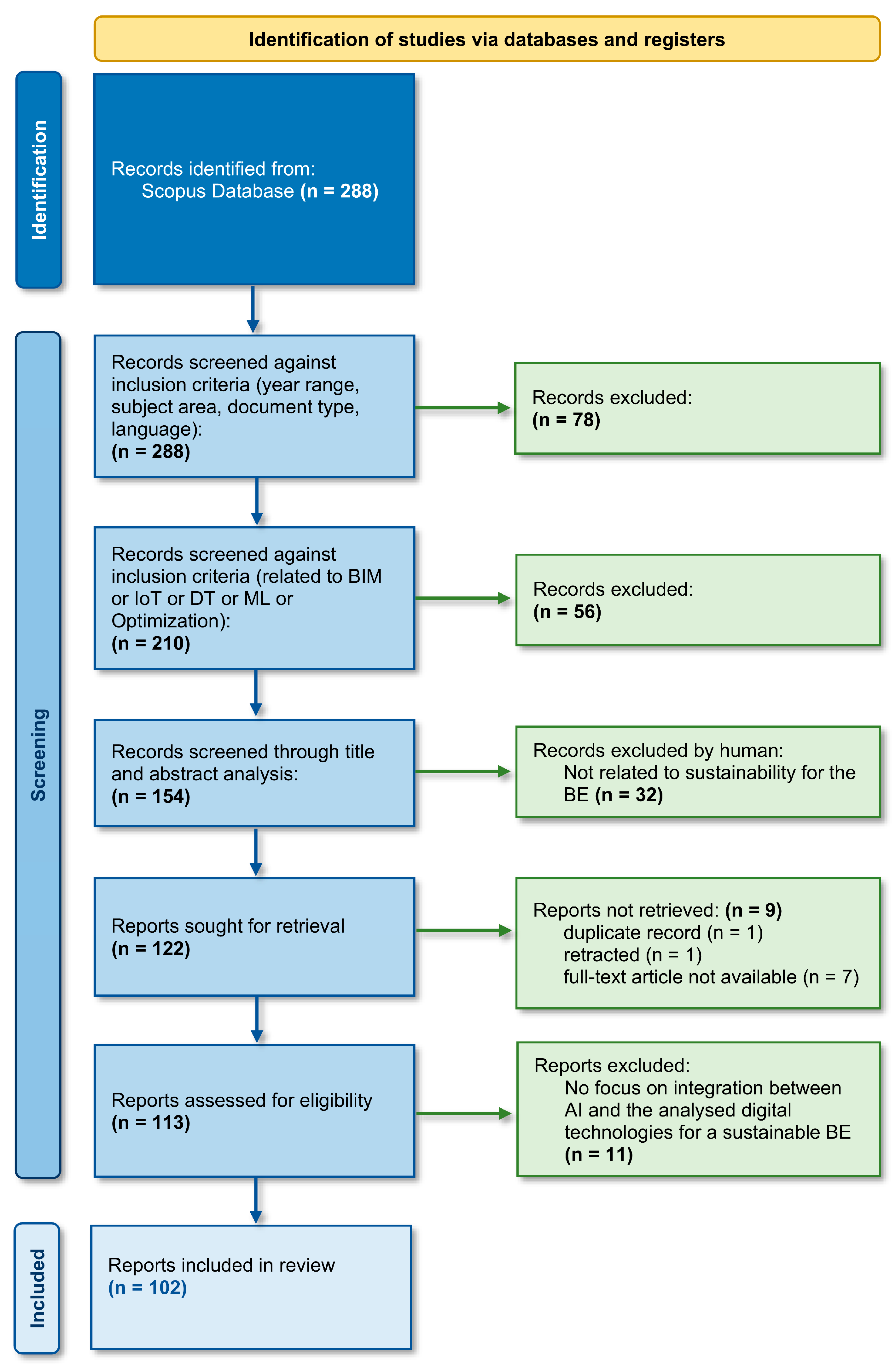
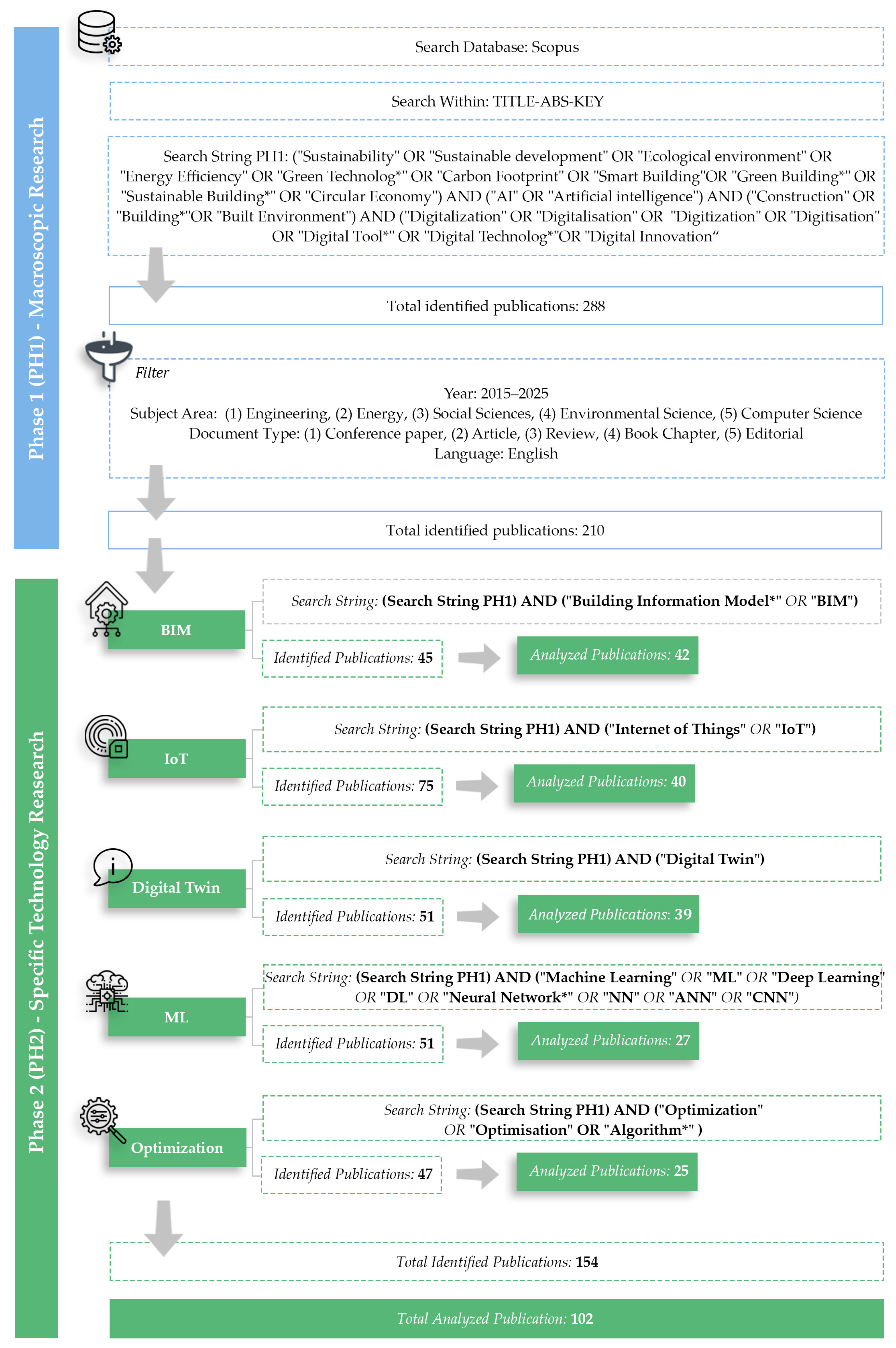
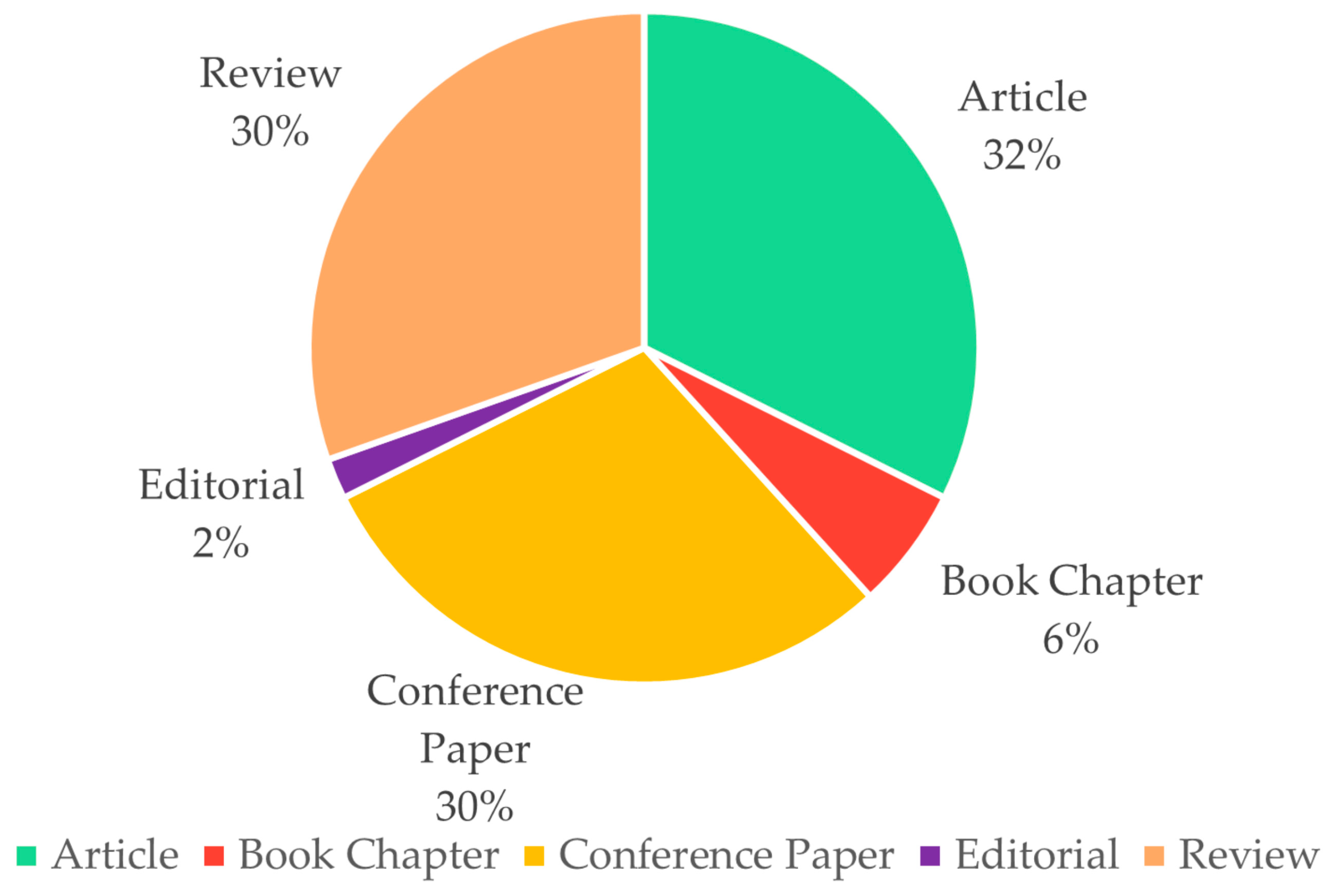
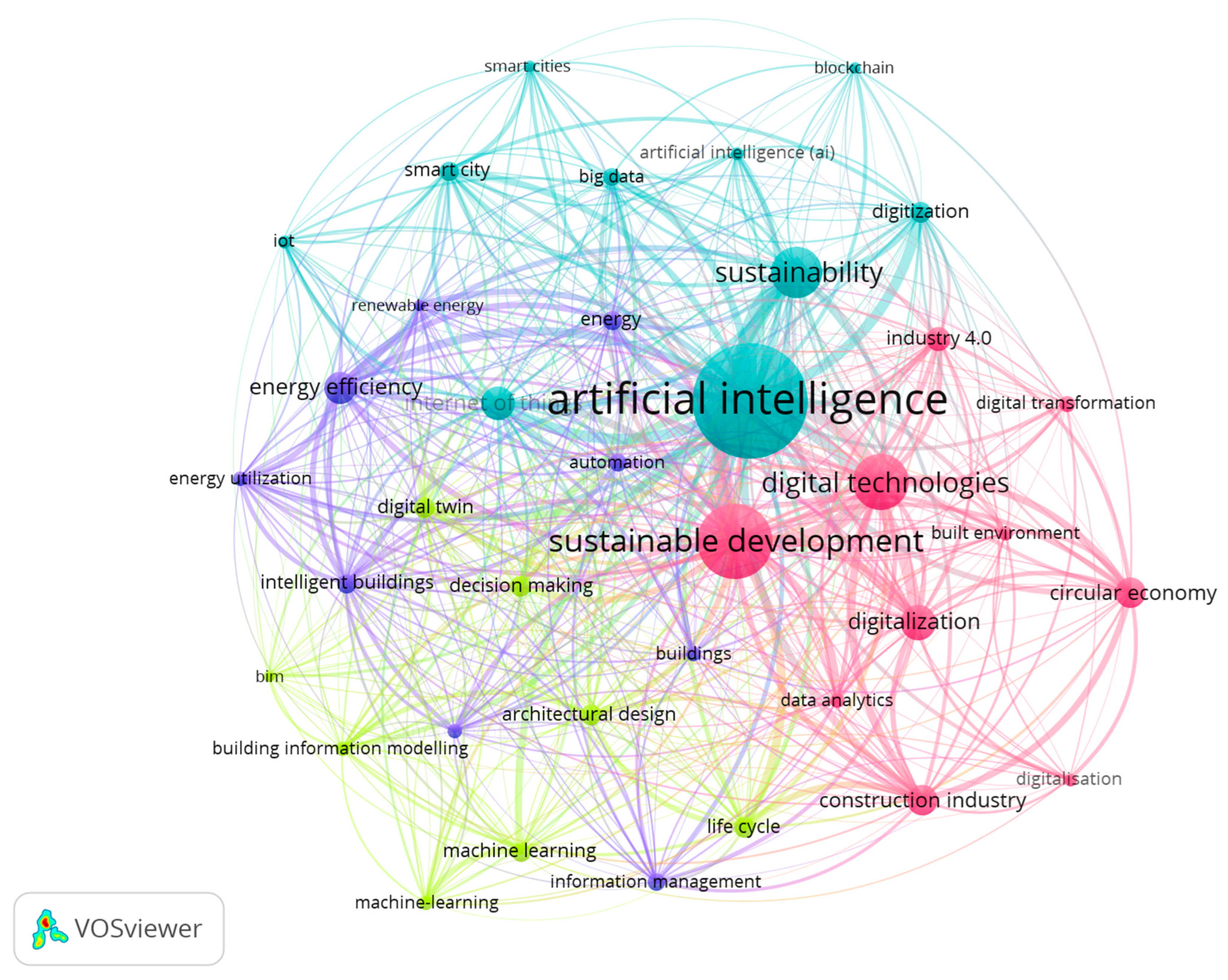

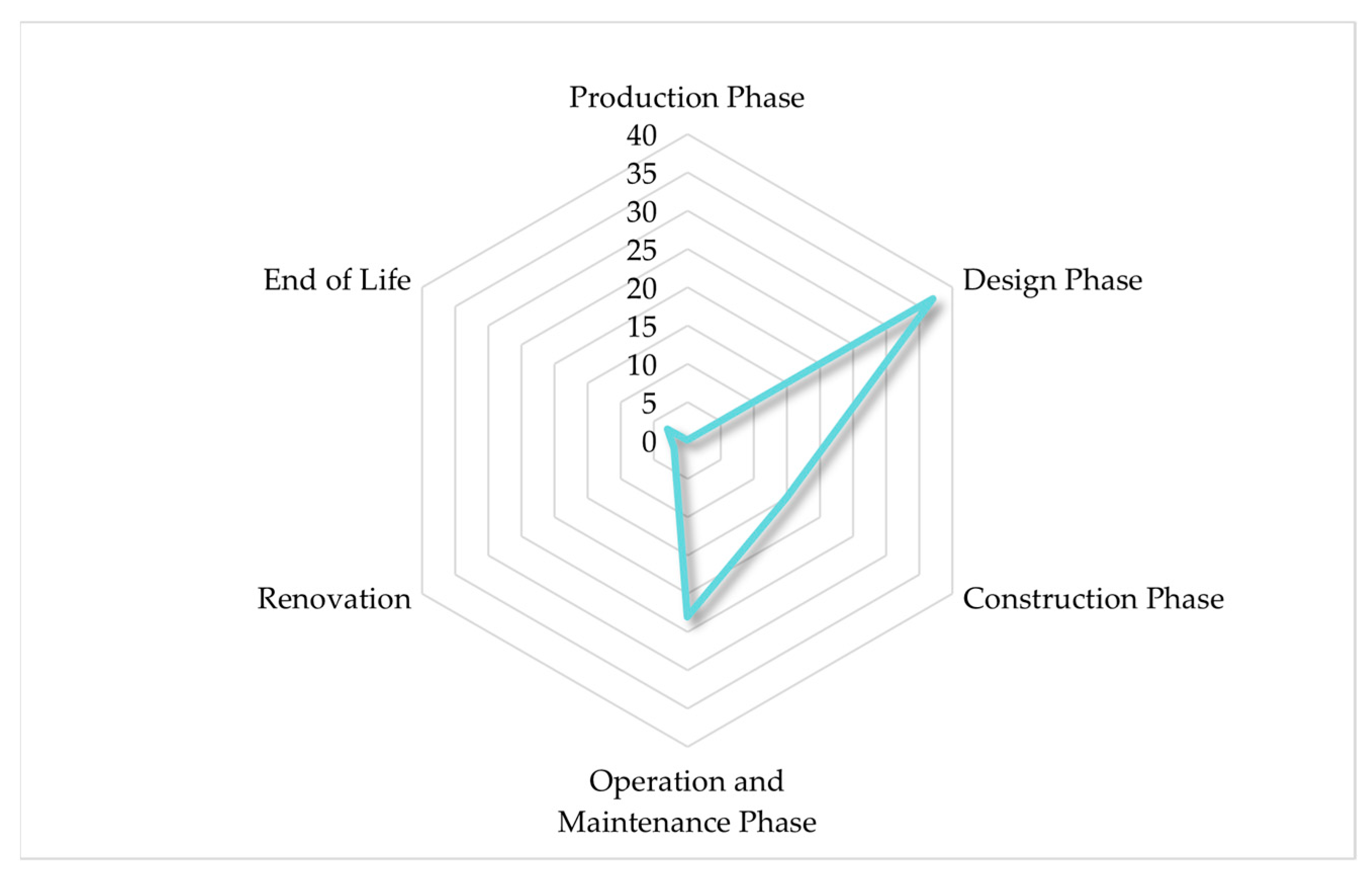
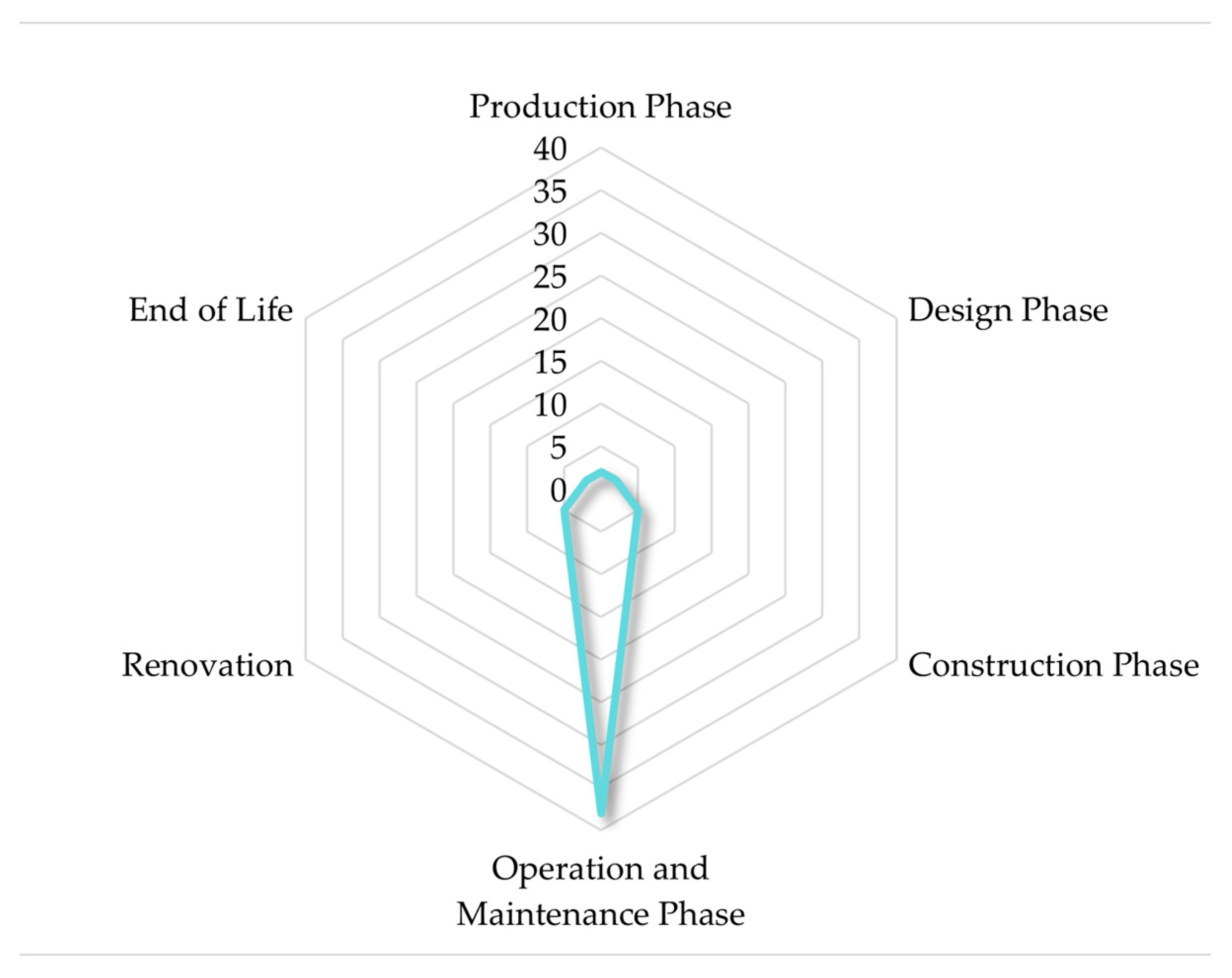
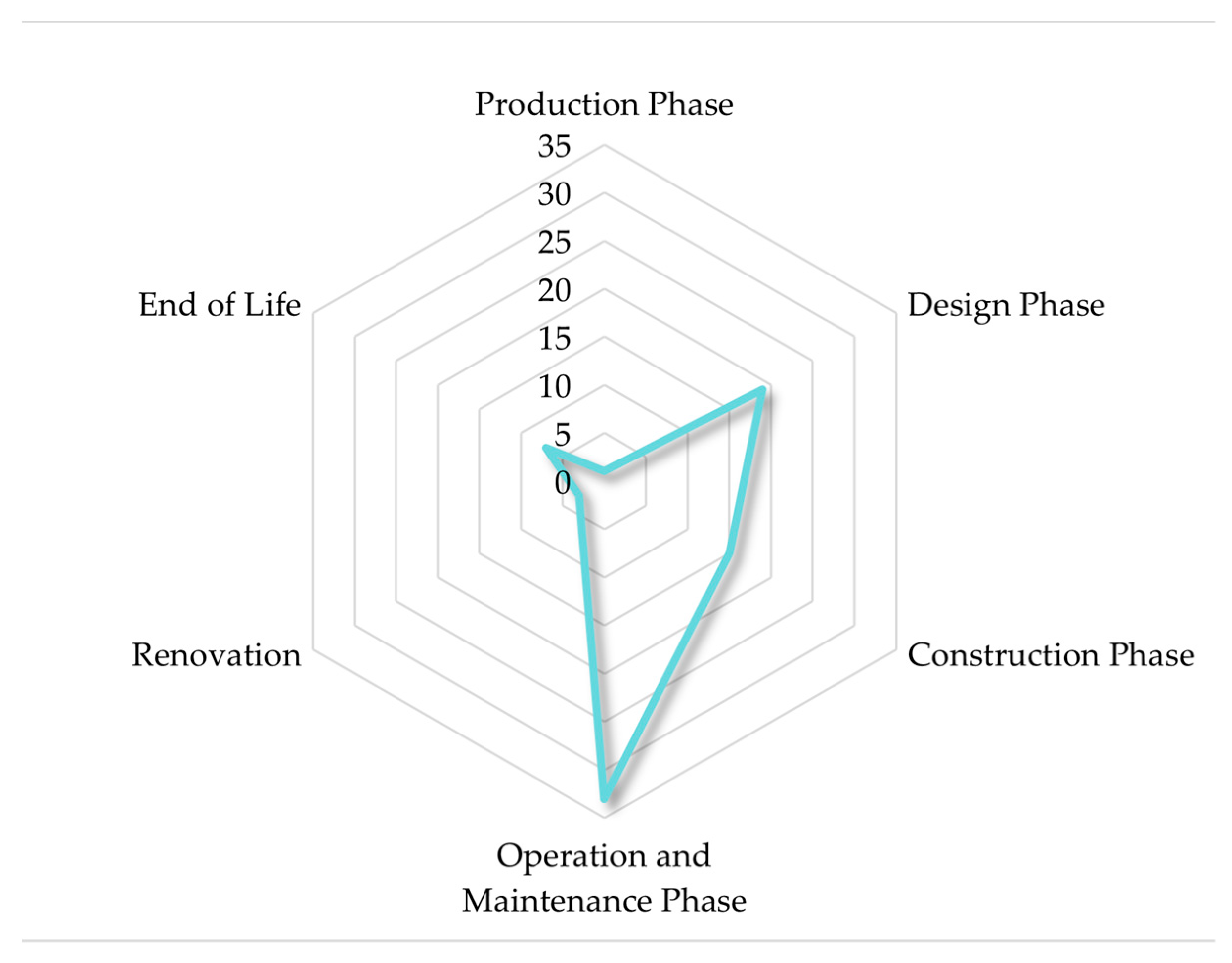
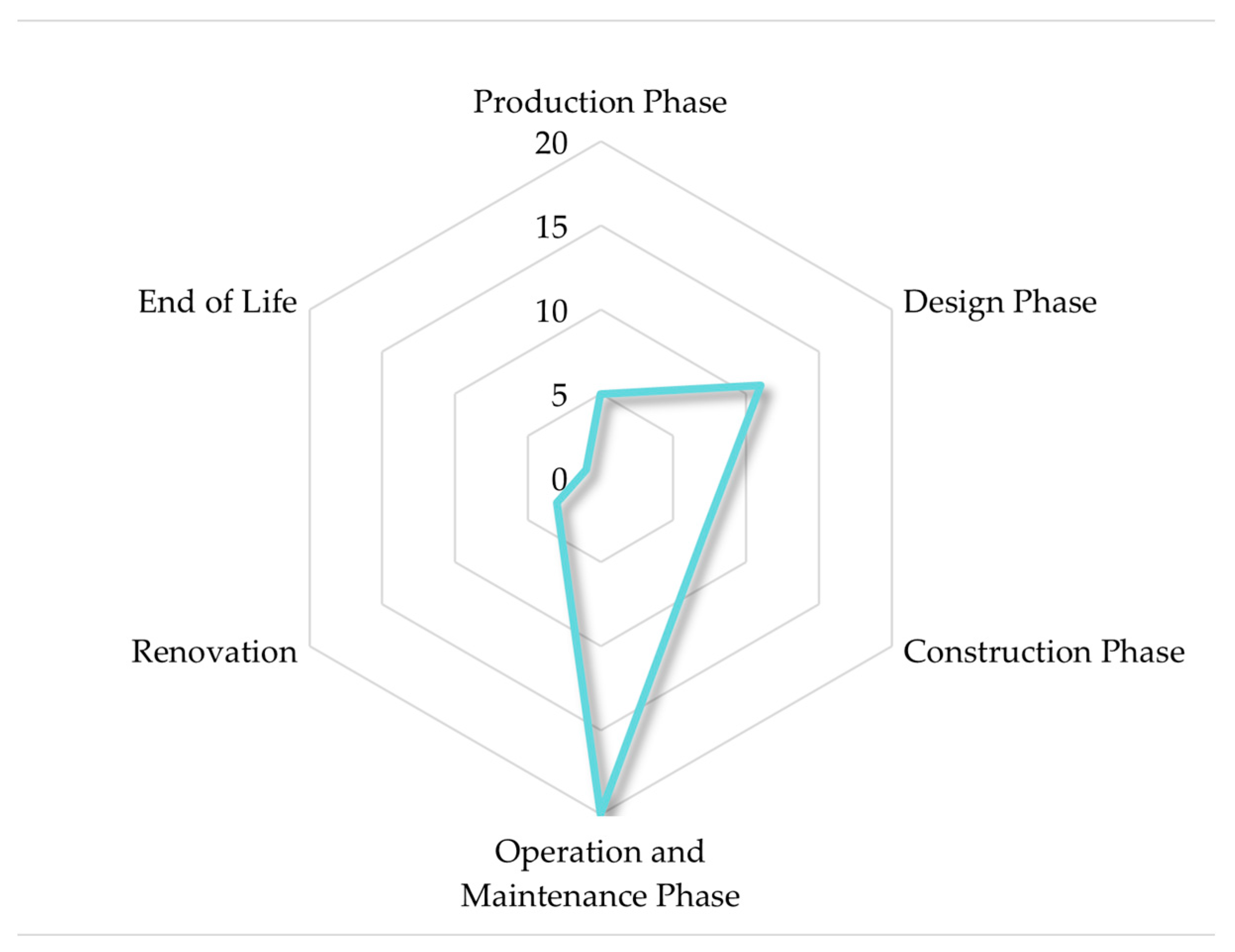
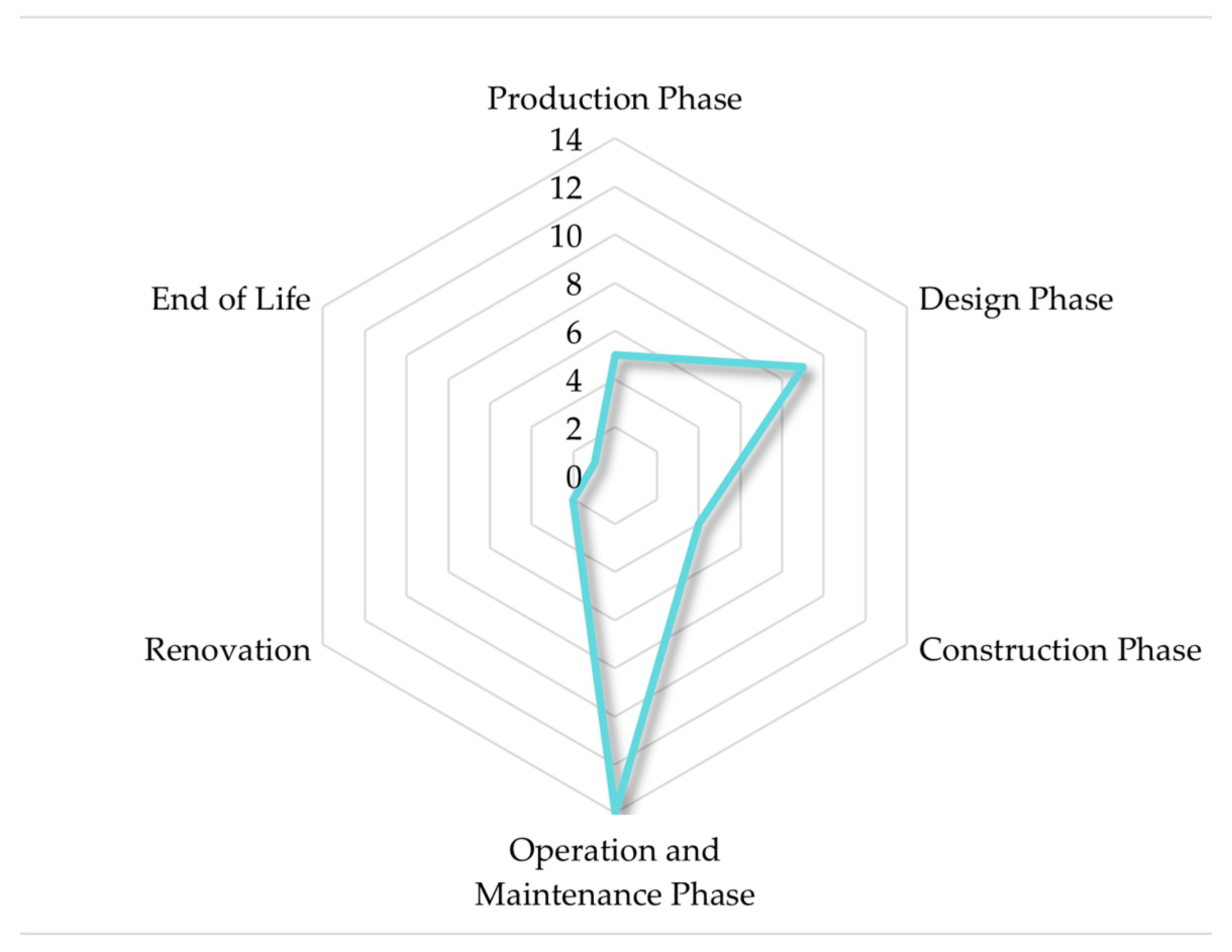


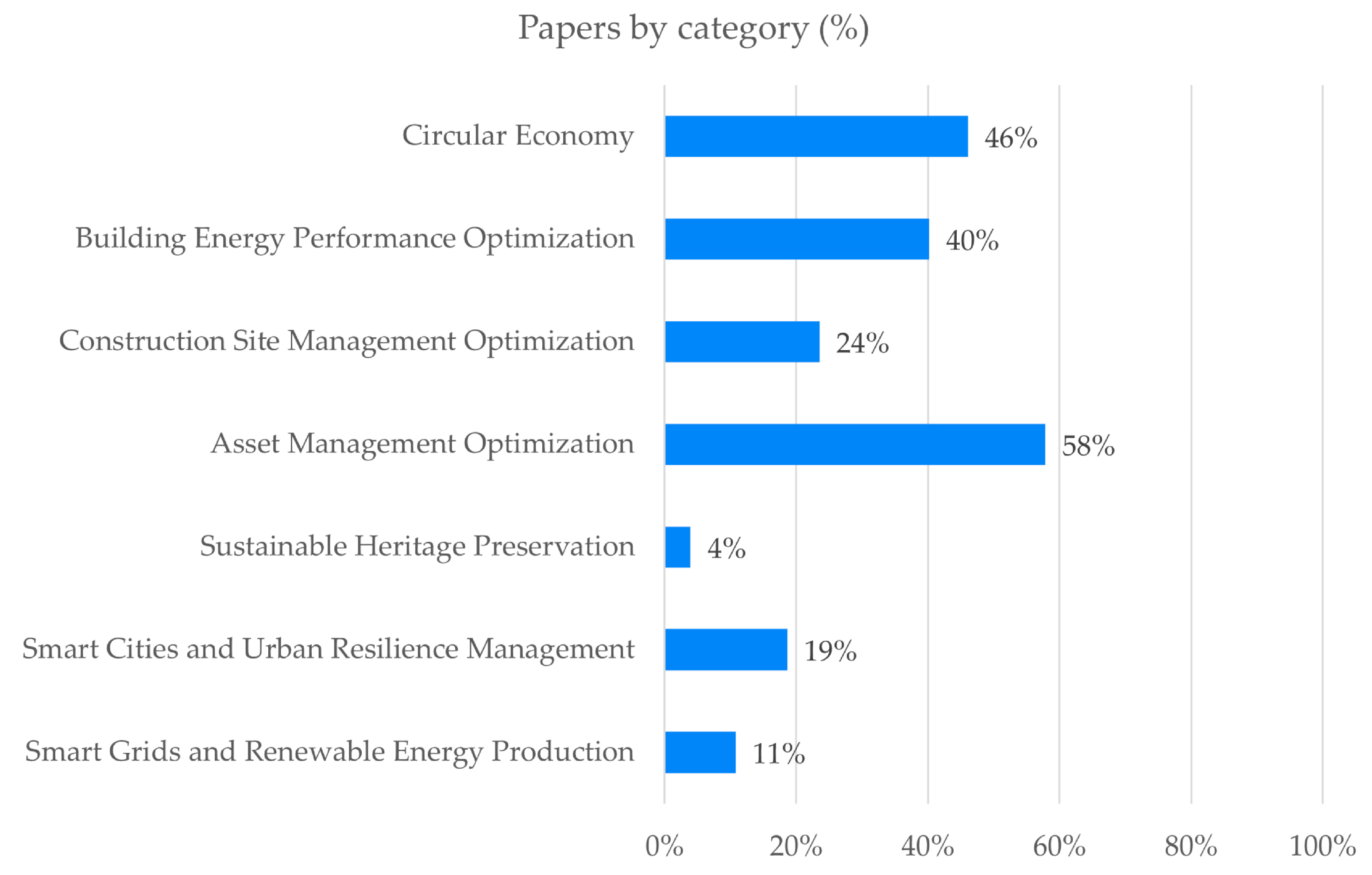
| Criteria | Inclusion | Exclusion |
|---|---|---|
| Time range | Papers published in the last decade (2015–2025) | Papers published before 2015 |
| Subject area | Engineering; Energy; Environmental sciences; Social sciences; Computer sciences | Papers concerning subject areas different from engineering, energy, environmental, social and computer sciences |
| Article type | Article; Conference paper; Review; Book Chapter; Editorial | Article types different from journal article, conference paper, review, book chapter, and editorial |
| Language | Papers written in English | Papers written in languages different from English |
| Relevance to specific technologies integrated with AI | Papers concerning BIM, IoT, DT, ML/DL, or Optimization techniques boosted by AI | Papers not regarding the integration of AI with BIM, IoT, DT, ML/DL, or Optimization techniques |
| Relevance to sustainability of the BE | Papers that address sustainability issues related to the BE | Papers not specifically concerning sustainability of the BE |
| Full-text availability | Full text available | Full text not available |
| Building Life Cycle Phase | References | Key Findings | Gaps |
|---|---|---|---|
| Production Phase | - | - | - |
| Design Phase | [6,7,12,16,26,27,28,29,30,31,32,33,34,35,36,37,38,39,41,42,45,46,47,48,49,50,51,52,53,54,55,56,57,58,59,60,61] |
|
|
|
| ||
|
| ||
| Construction Phase | [6,7,16,34,39,41,42,45,46,47,49,57,58,60,62] |
|
|
|
| ||
|
| ||
| Renovation Phase | [12,16] |
|
|
|
| ||
| Operation and Maintenance Phase | [6,7,16,28,33,35,37,39,40,41,42,43,44,45,46,47,56,57,61,62,63] |
|
|
|
| ||
|
| ||
| End-of-Life Phase | [16,33,61] |
|
|
|
| ||
|
|
| Building Life Cycle Phase | References | Key Findings | Gaps |
|---|---|---|---|
| Production Phase | [33,75] |
|
|
| Design Phase | [33,35] |
|
|
|
| ||
| Construction Phase | [33,41,49,62,67] |
|
|
|
| ||
|
| ||
| Renovation Phase | [43,67,76,77,78] |
|
|
|
| ||
| Operation and Maintenance Phase | [6,7,12,17,32,33,34,35,40,41,43,44,45,46,55,62,64,65,67,68,69,70,71,72,73,74,76,77,78,79,80,81,82,83,84,85,86,87] |
|
|
|
| ||
|
| ||
| End-of-Life Phase | [33,76] |
|
|
|
|
| Building Life Cycle Phase | References | Key Findings | Gaps |
|---|---|---|---|
| Production Phase | [95] |
|
|
| Design Phase | [6,12,28,35,41,45,46,49,50,54,56,57,82,88,89,90,93,96,97] |
|
|
|
| ||
|
| ||
| Construction Phase | [6,7,12,41,45,46,49,54,56,57,62,88,93,95,96] |
|
|
|
| ||
|
| ||
| Renovation Phase | [12,88,98] |
|
|
|
| ||
| Operation and Maintenance Phase | [6,7,12,28,35,39,40,41,43,44,45,46,54,55,56,57,62,72,77,81,82,84,86,88,91,92,93,94,96,97,98,99,100] |
|
|
|
| ||
|
| ||
| End-of-Life Phase | [12,46,54,56,88,93,101] |
|
|
|
|
| Building Life Cycle Phase | References | Key Findings | Gaps |
|---|---|---|---|
| Production Phase | [113,117,118,119,120] |
|
|
|
| ||
|
| ||
| Design Phase | [5,29,91,117,118,119,121] |
|
|
|
| ||
|
| ||
| Construction Phase | [27,41,62,113,114,117,119,122,123] |
|
|
|
| ||
|
| ||
| Renovation Phase | [77,98,114] |
|
|
|
| ||
| Operation and Maintenance Phase | [5,40,41,62,72,77,82,86,91,92,97,98,110,113,114,116,117,118,124] |
|
|
|
| ||
|
| ||
| End-of-Life Phase | [114] |
|
|
|
|
| Building Life Cycle Phase | References | Key Findings | Gaps |
|---|---|---|---|
| Production Phase | [61,75,118,120,126] |
|
|
|
| ||
|
| ||
| Design Phase | [6,29,46,48,61,89,118,121,129] |
|
|
|
| ||
|
| ||
| Construction Phase | [46,61,62,136] |
|
|
|
| ||
|
| ||
| Renovation Phase | [36,61] |
|
|
|
| ||
|
| ||
| Operation and Maintenance Phase | [5,6,46,61,62,73,79,91,92,97,109,137] |
|
|
|
| ||
|
| ||
| End-of-Life Phase | [61] |
|
|
|
| ||
|
|
| Sustainability Application Areas | Key Findings/AI Contribution | Challenges |
|---|---|---|
| Circular economy |
|
|
|
| |
|
| |
|
| |
|
| |
| Building energy performance optimization |
|
|
|
| |
|
| |
|
| |
|
| |
| Construction site management optimization |
|
|
|
| |
|
| |
|
| |
|
| |
| Asset management optimization |
|
|
|
| |
|
| |
|
| |
|
| |
| Sustainable heritage preservation |
|
|
|
| |
|
| |
|
| |
| Smart cities and urban resilience management |
|
|
|
| |
|
| |
|
| |
| Smart grids and renewable energy production |
|
|
|
| |
|
| |
|
|
Disclaimer/Publisher’s Note: The statements, opinions and data contained in all publications are solely those of the individual author(s) and contributor(s) and not of MDPI and/or the editor(s). MDPI and/or the editor(s) disclaim responsibility for any injury to people or property resulting from any ideas, methods, instructions or products referred to in the content. |
© 2025 by the authors. Licensee MDPI, Basel, Switzerland. This article is an open access article distributed under the terms and conditions of the Creative Commons Attribution (CC BY) license (https://creativecommons.org/licenses/by/4.0/).
Share and Cite
Ehtsham, M.; Parisi, G.; Pedone, F.; Rossi, F.; Zincani, M.; Congiu, E.; Marchionni, C. AI-Powered Advanced Technologies for a Sustainable Built Environment: A Systematic Review on Emerging Challenges. Sustainability 2025, 17, 8005. https://doi.org/10.3390/su17178005
Ehtsham M, Parisi G, Pedone F, Rossi F, Zincani M, Congiu E, Marchionni C. AI-Powered Advanced Technologies for a Sustainable Built Environment: A Systematic Review on Emerging Challenges. Sustainability. 2025; 17(17):8005. https://doi.org/10.3390/su17178005
Chicago/Turabian StyleEhtsham, Muhammad, Giuliana Parisi, Flavia Pedone, Federico Rossi, Marta Zincani, Eleonora Congiu, and Chiara Marchionni. 2025. "AI-Powered Advanced Technologies for a Sustainable Built Environment: A Systematic Review on Emerging Challenges" Sustainability 17, no. 17: 8005. https://doi.org/10.3390/su17178005
APA StyleEhtsham, M., Parisi, G., Pedone, F., Rossi, F., Zincani, M., Congiu, E., & Marchionni, C. (2025). AI-Powered Advanced Technologies for a Sustainable Built Environment: A Systematic Review on Emerging Challenges. Sustainability, 17(17), 8005. https://doi.org/10.3390/su17178005









